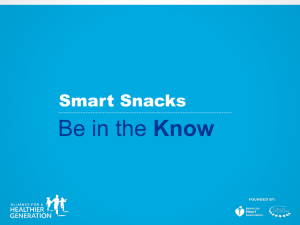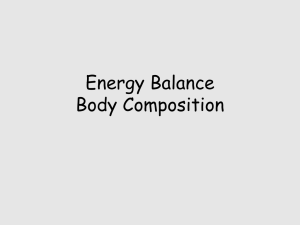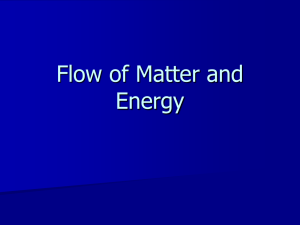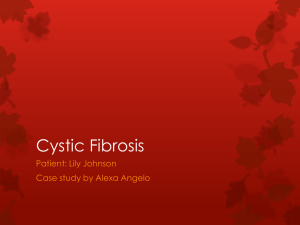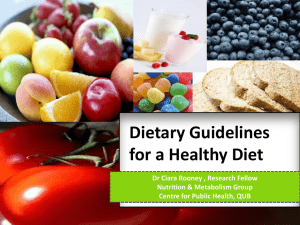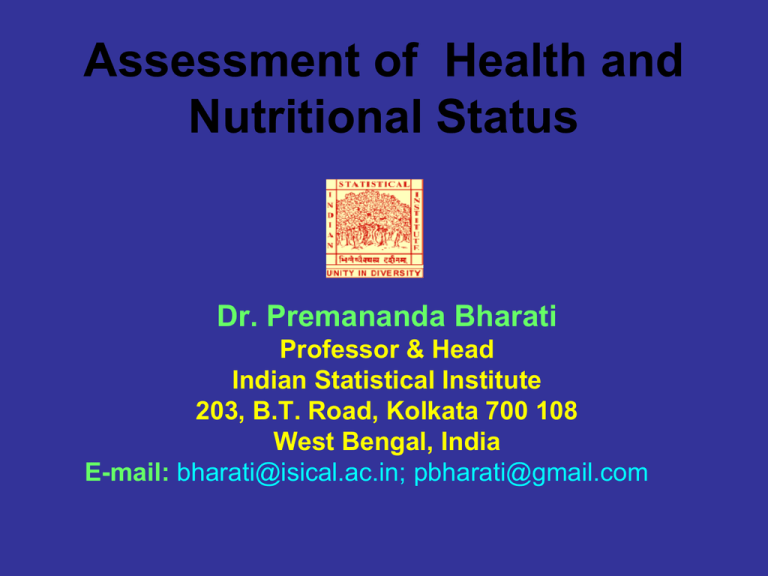
Assessment of Health and
Nutritional Status
Dr. Premananda Bharati
Professor & Head
Indian Statistical Institute
203, B.T. Road, Kolkata 700 108
West Bengal, India
E-mail: bharati@isical.ac.in; pbharati@gmail.com
What is health?
WHO (1971) defined “health” as “a
complete physical, mental and social
well being and not merely an absence
of disease or infirmity”.
Nutrition
What is nutrition?
Nutrition is the process in which we consume food or
nourishing liquids, digest and absorb them and use them
for health and growth.
What is nutrients?
Nutrients are chemical elements and compounds found
in the environment that plants and animals need to grow
and survive.
What are the different types of nutrient?
(i) Energy-producing nutrients (also called energyyielding nutrients or macronutrients) like carbohydrates,
fat and protein.
(ii) Micronutrients often refer to vitamins and minerals.
1)
2)
3)
4)
1)
2)
3)
What is energy (calorie)?
Calorie is an energy measurement unit.
One calorie of heat energy is required to raise one
gram of water by one degree Celsius.
1,000 calories equal 1 kilocalorie (kcal), which is
commonly used in measuring food energy.
Estimation of energy requirements for healthy
individuals takes account of age, gender, body weight
and activity patterns..
What is protein?
Proten is mainly used for growth and body repair.
When there is an insufficient intake of energy, protein
would be broken down and used as body fuel, which
may lead to protein-energy malnutrition.
One gram of protein provides 4 kcal.
What is carbohydrate?
1) Carbohydrate is the major energy source in an average
diet, which is also the preferred fuel.
2) One gram of carbohydrate provides 4 kcal.
3) When adequate carbohydrate is provided in the diet,
protein would be spared for growth and repair.
4) Carbohydrate can be divided into three main types:
monosaccharides,
disaccharides
and
complex
carbohydrate (starches and dietary fibres).
What is fat?
1) Fat is technically known as triglycerides, which is a
class of lipids.
2) Fat is a concentrated energy source, which provides 9
kcal for each gram of fat.
3) Fat carries fat-soluble vitamins (i.e. vitamin A,D,E and
K).
4) Fat prevents heat loss in extreme temperatures and
protects organs against shock.
5) Fat can be divided into saturated fat and unsaturated
fat depending on their chemical structures.
6) Unsaturated fat can be further divided to mono- and
poly-unsaturated fats.
7) Excess fat intake has been linked to major health
problems, including an increased risk of heart disease,
obesity, hypertension, diabetes and certain types of
cancers.
INDICATORS OF HEALTH AND NUTRITIONAL
STATUS
Direct Indicators:
-- Nutritional Anthropometry
-- Clinical Assessment
-- Bio-chemical Estimations
Indirect Indicators:
-- Dietary assessment
-- Vital Statistics
In addition, Secondary Data:
-- Socio-economic
-- Socio-demographic
-- Environmental
NUTRITIONAL ANTHROPOMETRY
MEASUREMENTS
- Using Anthropometric Instruments
REFERENCE VALUES / STANDARDS
- National, International
INDICES
- Computed; Age dependent / Independent
CLASSIFICATIONS
- Grading of Nutritional Status
ANTHROPOMETRIC MEASUREMENTS
Anthropometry, which measures the dimensions and
composition of the human body.
-Weight (kgs)
-Height (cms)
- Mid Upper Arm Circumference (cms)
-Waist Circumference (cms)
-Hip Circumference (cms)
- Fat fold thickness (mms) : at Triceps,
Biceps, Supra-Iliac, Sub-scapular
Nutritional Anthropometry
Weight :
- Total Body mass
- Simple, widely used
- Sensitive to small changes in nutrition
Height :
- Genetically Determined
- Environmentally influenced
- Stunting Reflects chronic undernutrition
MUAC :
- Reflects muscle/fat
- Easy to measure, used for quick screening
- Independent of age (1-5 years)
FFT:
- Measures body fat
- Correlates well with total body fat
REQUIREMENTS FOR NUTRITIONAL ANTHROPOMETRY
Standard equipment:
- Accuracy / Consistency,
Appropriate techniques:
- Training & Standardization
Correct assessment of age:
Reference values:
- For comparison and computation of indices
Classification:
- For grading nutritional status
Reference Values
Anthropometric measurements obtained on
statistically adequate number of individuals who are
well nourished, living in an environment free from
constraints of any sort and have capacity to reach
maximum growth potential at each age group/Gender.
-- National
Eg. ICMR, Well-to-do Hyderabad pre-school
children, IAP Standards
-- International
Eg. NCHS, Harvard, MGRS, WHO, NHANES
CURRENT REFERENCE VALUES
National Center for Health Statistics
(NCHS) 0- 18 years / By gender.
(Hamill et. al. AJCN, 1979 - WHO/1983)
HARVARD (0-60 months / Gender pooled)
(Jelliffe et. al. WHO Mono. 53 - 1966)
The National Health and Nutrition Examination Survey
(NHANES) 9-17 years/Gender Specific
BMI Centiles.
World Health Organization (1995)
WHO (0- 5 years and 5-18 years / By gender)
(Official website of WHO, Child growth standards)
ANTHROPOMETRIC INDICES
Weight for age
Height for age
Weight for Height
Body Mass Index
NUTRITIONAL GRADING / CLASSIFICATIONS
Preschool Children:
GOMEZ CLASSIFICATION
WEIGHT FOR AGE
(% of NCHS
Standards)
90
NUTRITIONAL GRADE
Normal
75 – 89.9
Grade I (Mild Undernutrition)
60 – 74.9
Grade II (Moderate Undernutrition)
< 60
Grade III (Severe Undernutrition)
GOMEZ CLASSIFICATION
Gomez et. al. (J Trop Ped 1956)
Based on Prognosis of children admitted to
Hospitals in Mexico
- Significantly higher incidence of mortality among
children with <60% of standard wt for age
- Significantly higher morbidity among children
with 60-75% of standard weight for age
IAP CLASSIFICATION
(Indian Academy of Paediatrics)
WEIGHT FOR
AGE
(% of Harvard
Standard)
80
NUTRITIONAL GRADE
Normal
70 – 89.9
Grade I (Mild Undernutrition)
60 – 69.9
Grade II (Moderate Undernutrition)
50 – 59.9
Grade III (Severe Undernutrition)
< 50
Grade IV (Severe Undernutrition)
STANDARD NORMAL DISTRIBUTION
“Measuring Changes in Nutritional Status”
(WHO, Geneva 1983).
Normal
2%
14%
-3.0 -2.0
-1.0
34%
34%
0.0
SD Score
14%
1.0
( 2SD = 96 %)
2%
2.0
3.0
STANDARD DEVIATION (SD) CLASSIFICATION
NUTRITIONAL GRADE
CUT-OFF LEVEL
WEIGHT FOR
AGE
Median – 2 SD
Normal
Normal
Normal
Median – 3 SD to
Median – 2 SD
Moderate
Underweight
Moderate
Stunting
Moderate
Wasting
< Median – 3 SD
Severe
Underweight
Severe
Stunting
Severe
Wasting
HEIGHT FOR WEIGHT FOR
AGE
HEIGHT
Nutritional gradation based on BMI (adult)
Body Mass Index (BMI) = Weight in kg/ height in meter square
Nutritional gradation based on BMI (adult)
Classification
CED grade III (Severe thinness)
Cut-off points (BMI = kg/m2)
<16.00
CED grade II (Moderate thinness)
16.00-16.99
CED grade I (Mild thinness)
17.00-18.49
Normal
18.50-24.99
Overweight
25.00-29.99
Obese
≥ 30.00
Urgent need :
There is need to adopt the new WHO growth
standards of 0-18 years Children by all.
The Growth charts in ICDS need to be
modified using SD classification criteria.
The functionaries have to be trained and
oriented to these changes.
The existing data need to be re-analysed using
new reference values to enable comparisons.
There is urgent need to build new reference
values (age, sex and population specific) for
Indian children and adult.
Measuring calorie through diet survey
Diet survey
(i) One or seven days dietary survey is conducted in
each household. Each raw food item to be cooked for
each meal is weighed in a Salter pan type balance prior
to cooking. Household members not taking meal at
home or guest(s) taking meal in the household are also
recorded. Respondents are asked on the next day,
whether any food had been left over or consumed by
their livestock or shared with neighbour. If yes, the
amounts are recorded. Approximate amounts (weight) of
food items consumed by member(s) outside home
during that day are also recorded.
(ii) 24 hours recall method is conducted in each member
of the households through pre-tested structured
questionnaire. For children specifically preschool,
question should be asked to their mothers.
Nutrient consumption
(i) The nutritive values are estimated from the food
composition tables like Indian Council of Medical
Research (ICMR) (Gopalan et al., 2007). Calorie need of
an individual is taken as the basis of estimation of
consumption unit. Besides age and sex of the household
members, the physiological status like stage of
pregnancy or lactation of the woman of in the household
is also taken into consideration.
(ii) Consumption of calories, protein and fat are classified
on the basis of Recommendatory Dietary Allowances
(RDA) of India (ICMR, 2004).
Consumption unit of household by age and sex in India
Individual
Age
(years)
Calories according to ICMR
recommended allowances
Consumption
unit1
Male
60
2875
2875/2875= 1
Male
25
2875
2875/2875= 1
Male
12
2190
2190/2875= 0.76
Female
55
2225
2225/2875= 0.77
Female
21
2225
2225/2875= 0.77
Female
18
2060
2060/2875= 0.72
Female
11
1970
1970/2875 =0.68
1Total
household consumption unit = 5.70
Energy Requirements of Boys and Girls at Different Age Groups: A
Comparison Between FAO and ICMR Estimates
Boys
Age groups
Body
weigh
t
Girls
Daily energy requirements
FAO
ICMR
Body
weigh
t
Daily energy requirements
FAO
ICMR
Kg.
Kcal/d/k
g
Kcal/
d
Kcal/d
Kg.
Kcal/d/kg
Kcal/d
Kcal/d
(1)
(2)
(3)
(4)
(5)
(6)
(7)
(8)
(9)
0-5 months
5.4
93
502
583
5.4
92
497
583
6-11 months
8.6
80
688
843
8.6
79
679
843
1-3 years
12.2
82
1000
1240
12.2
79
964
1240
4-6 years
19.0
75
1425
1690
19.0
72
1368
1690
7-9 years
26.9
69
1856
1950
26.9
64
1722
1950
10-12 years
35.4
62
2195
2190
31.5
55
1733
1970
13-15 years
47.8
56
2697
2450
46.7
47
2195
2060
16-17 years
57.1
51
2912
2640
49.9
44
2160
2060
Daily Energy Requirements for Men and Women in India
Age group
Lifestyle
Men
Mean
weigh
t
BM
R
Kg.
Kcal/
d/kg
Kcal/
d
Women
Daily energy
requirements
FAO
ICMR
Kcal/ Kcal/d
d/kg
Mean
weigh
t
BMR
Daily energy
requirements
Kg.
Kcal/
d/kg
Kcal/
d
Kcal/
d/kg
Kcal/d
FAO
ICMR
(1)
(2)
(3)
(4)
(5)
(6)
(7)
(8)
(9)
(10)
(11)
(12)
18-29.9
Sedentary
60
27
2479
41.3
-
50
25
1912
38.2
-
Moderate
60
2851
47.5
-
50
2200
44.0
-
Heavy
60
3645
60.7
-
50
2812
56.2
-
Sedentary
60
2387
39.8
-
50
1912
38.2
-
Moderate
60
2746
45.8
-
50
2200
44.0
-
Heavy
60
3510
58.5
-
50
2812
56.2
-
Sedentary
60
2020
33.7
-
50
1683
33.7
-
Moderate
60
2323
38.7
-
50
1912
38.2
-
Heavy
60
2970
49.5
-
50
2475
49.5
-
Sedentary
60
2367
39.4
2425
50
1882
37.6
1875
Moderate
60
2722
45.4
2875
50
2165
43.3
2225
Heavy
60
3480
58.0
3800
50
2768
55.4
2925
30-59.9
60 or more
18 or more
26
22
25.8
25
22
24.6
Health
What is health?
I.
WHO (1971) defined “health” as “a complete
physical, mental and social well being and not merely
an absence of disease or infirmity”.
The concept of health varies among different culture
and geographical settings (Colson and Selby, 1974)
and the cognition of the concept depends upon the
value system of that particular society (Opler, 1963).
It is, therefore, important to measure health based on
the facts relating to how it is defined (Mc Dowell et
al., 2004)
II.
III.
Physical measure of health
a) Infant and child mortality
b) Nutritional status through
anthropometric measurements:(a) children (b) adult
c) Haemoglobin status
d) Blood glucose status
e) Blood pressure
f) Morbidity pattern etc.
Nutritional status of preschool (0-60 months)
and others children (5–19 years)
Three nutritional indices as weight for age z score
(WAZ), height for age z score (HAZ), weight for height z
score (WHZ) are calculated using World Health
Organization (WHO) standard (WHO, 2006) for
preschool children.
Similar indices are used along with Body Mass Index
(BMI) percentile using National Center for Health
Statistics (NCHS) (Frisancho, 1990) and also World
Health Organization (WHO, 2000) for children aged 5-19
years.
Z- Scores <-2 SD of the above indices are considered as
underweight (WAZ), stunting (HAZ) and wasting (WHZ).
<5th percentile of BMI was considered as undernutrition.
All the indices were internationally recommended (WHO,
1995).
How to calculate Z score
Z-score is defined as the deviation of the value observed
for an individual from the median of the reference
population, divided by the standard deviation (SD) of the
reference population.
Z- score = (observed value) – (median of the reference population)
SD of the reference population
LIKE
Z- score = 8 kg in weight – 10 kg in weight
2 kg in weight
= - 1 (normal)
Nutritional status among adult
(i) Body Mass Index (BMI) = Weight (kg)/ Height
(m2)...…………... (James et al., 1988)
Nutritional gradation based on BMI (adult)
The subjects are classified on the basis of chronic energy deficiency (CED)
grades (James et al., 1988; WHO, 1995) as follows:
Cut-off points (BMI = kg/m2)
Classification
CED grade III (Severe thinness)
<16.00
CED grade II (Moderate thinness)
16.00-16.99
CED grade I (Mild thinness)
17.00-18.49
Normal
18.50-24.99
Overweight
25.00-29.99
Obese
≥ 30.00
Anthropometric
Classification
BMI(kg/m2)
Principal cut-off points
Additional cut-off points
<18.50
<18.50
Severe thinness
<16.00
<16.00
Moderate thinness
16.00 - 16.99
16.00 - 16.99
Mild thinness
17.00 - 18.49
17.00 - 18.49
Underweight
Normal range
18.50 - 24.99
Overweight
≥25.00
Pre-obese
25.00 - 29.99
Obese
≥30.00
Obese class I
30.00 - 34-99
Obese class II
35.00 - 39.99
Obese class III
≥40.00
18.50 - 22.99
23.00 - 24.99
≥25.00
25.00 - 27.49
27.50 - 29.99
≥30.00
30.00 - 32.49
32.50 - 34.99
35.00 - 37.49
37.50 - 39.99
≥40.00
Source: Adapted from WHO, 1995, WHO, 2000 and WHO 2004
General consequences of undernutrition
Increase in morbidity and mortality
Constant weight loss, muscular
hypercatabolism
Psychological disorder like long depressive
syndromes
Immune deficiency
Digestive disorder
Food-drug interactions and toxicity
Consequences of micronutrient deficiencies
General consequences of overnutrition
Increase the risk of Atherosclerosis
Increase risk of hypertension, diabetes,
stork, heart disease, and some form of
cancer
High mortality rate
Disturbance of endocrine function
In females, it increases endometrial,
cervical, ovarian cancer
Haemoglobin
• Oxyhaemoglobin is estimated immediately after
collection of blood samples using Sahli’s
haemomter, following standard technique (WHO,
1968)
Classification of haemoglobin (gm/dl) level (adult and adolescents)
The subjects were classified on the basis of different grades of haemoglobin
(WHO, 1975) as follows:
Classification
Cut-off points (gm/dl)
Male
Female
≤ 7.00
≤ 7.00
Moderate anaemia
7.01-10.00
7.01-10.00
Mild anaemia
10.01-12.99
10.01-11.99
≥13.00
≥ 12.00
Severe anaemia
Normal anaemia
Haemoglobin level among adolescents is classified on the basis of international
standard as normal (≥ 12.0 gm/dl) and anaemic (<12 gm/dl) (WHO, 1992).
Mean per capita consumption of calories, protein, and fats
Calories (kcl)
Protein (gms)
Fats (gms)
Year
Round
Rural
Urban
Rural
Urban
Rural
Urban
1983
38
2,240
2,070
63.5
58.1
27.1
37.1
1987–8
43
2,233
2,095
63.2
58.6
28.3
39.3
1993–4
50
2,153
2,073
60.3
57.7
31.1
41.9
1999–0
55
2,148
2,155
59.1
58.4
36.0
49.6
2000–1
56
2,083
2,027
56.8
55.3
34.6
46.1
2001–2
57
2,018
1,982
54.8
54.2
33.6
46.1
2002(2) 58
2,025
2,014
55.4
54.9
34.7
47.0
2003
59
2,106
2,020
58.0
55.5
36.4
46.7
2004(1) 60
2,087
2,036
56.9
55.9
35.5
46.8
2004–5
2,047
2,021
55.8
55.4
35.4
47.4
61
Source: Authors’ calculations from NSS data. Nutrients are calculated, following the NSS practice, by
multiplying reported quantities (purchased, grown, or received outside the market) by a set of nutrient
conversion factors which are themselves revised from time to time.
(Deaton and Drèze, 2008)
Rural per capita calorie consumption, 1983 to 2004-5
(Deaton and Drèze, 2008)
Urban per capita fat consumption, 1983 to 2004-5
(Deaton and Drèze, 2008)
Potential calorie intake of poverty-line class in different states in India
State
Rural
Urban
Calories
per day
Percentage of
norm (2400)
Calories
per day
Percentage of
norm (2400)
Andhra Pradesh
2424
101
2457
117
Assam
2258
94
1481
71
Bihar
2252
94
2605
124
Gujarat
2197
92
2069
99
Haryana
2311
96
1526
73
Himachal Pradesh
2714
113
2277
108
Karnataka
2304
96
2682
128
Kerala
1456
61
2004
95
Madhya Pradesh
2584
108
2360
112
Maharashtra
2326
97
2451
117
Orissa
2507
104
2720
130
Punjab
2266
94
2183
104
Rajasthan
3016
126
2561
122
Tamil Nadu
2215
92
2050
98
Uttar Pradesh
2266
94
2027
97
West Bengal
2633
110
2089
99
(Sen, 2005)
State and zone wise percentage distribution of different types of nutritional status among the under
six children of India by sex
Zones and States
Boys
Girls
Severely
anemic
Under weight
and
severely
anemic
N
Under
w
ei
gh
t
Under
wei
ght
Severely
Anemic
Under weight
and
severely
anemic
4254
24.8
12.5
2.9
3957
15.7
12.2
2.0
956
29.6
12.2
3.3
904
14.7
10.8
2.2
Assam
1152
27.4
12.4
2.8
1046
23.7
11.6
2.9
Manipur
1002
17.7
10.8
2.1
915
8.6
12.8
0.9
87
41.4
9.2
2.3
83
39.8
14.5
3.6
Mizoram
311
22.2
9.3
1.9
336
9.8
6.5
0.9
Nagaland
195
17.4
5.6
1.0
178
18.5
6.2
1.1
Sikkim
375
20.8
22.1
4.8
315
10.2
22.2
2.5
Tripura
176
36.4
19.3
5.1
180
16.7
18.3
2.2
20993
51.1
19.8
11.3
20010
50.9
20.9
11.7
Bihar
8751
54.0
21.6
13.1
8127
55.5
24.1
15.3
Jharkhand
3635
55.5
18.8
12.3
3383
54.1
18.3
10.8
Orissa
5559
46.9
21.4
10.5
5648
45.0
21.4
9.9
West Bengal
3048
45.2
12.9
6.4
2852
45.6
13.7
6.5
31656
57.9
20.1
13.0
29326
55.3
20.7
12.9
10482
58.2
17.4
10.7
9719
56.2
17.2
10.3
2845
50.5
25.2
13.5
2816
47.2
25.2
13.0
18329
59.5
20.9
14.2
16791
56.1
22.0
14.3
N
North –East
Arunachal Pradesh
Meghalaya
East
Central
Madhya Pradesh
Chattisgarh
Uttar Pradesh
West
12109
51.0
31.4
16.9
10939
51.1
31.0
16.7
167
34.1
7.2
4.2
162
34.0
8.6
3.7
4804
51.0
36.4
20.1
4179
50.7
36.3
19.6
Daman & Diu
266
44.0
28.9
14.7
258
41.5
30.2
11.2
Dadra & Nagar Haveli
262
51.1
50.4
26.7
255
47.8
49.0
25.9
6610
51.7
27.8
14.6
6085
52.4
27.3
14.9
22899
47.8
20.1
10.8
19365
42.8
20.7
10.3
Haryana
5629
37.8
24.2
10.2
4501
31.9
25.3
9.1
Himachal Pradesh
1288
40.0
16.5
7.9
1146
34.6
16.6
5.8
767
22.4
3.4
0.4
738
20.7
4.6
0.9
Delhi
1244
35.5
17.8
6.8
1089
35.4
20.1
7.7
Punjab
3687
41.8
23.8
11.2
2939
36.2
22.9
10.0
Rajasthan
8330
59.5
19.1
12.8
7148
56.5
20.3
13.4
Chandigarh
58
44.8
29.3
15.5
72
26.4
29.2
6.9
Uttaranchal
1896
62.0
15.6
11.4
1732
45.6
16.0
9.5
12294
42.4
18.0
8.2
11719
37.2
17.9
7.4
Andhra Pradesh
2647
45.6
22.4
11.0
2469
38.0
22.0
9.7
Karnataka
2727
48.2
21.1
10.7
2609
43.8
19.3
9.7
752
37.9
2.9
1.3
714
34.9
2.7
1.1
Tamil Nadu
5420
39.0
16.9
6.8
5209
34.3
17.7
6.3
Pondichery
478
39.2
14.4
5.6
718
33.6
14.8
5.6
421
33.3
18.0
2.9
425
28.2
10.4
3.5
360
33.6
10.3
3.1
365
25.2
10.1
3.0
62
31.1
11.5
1.6
60
46.7
11.7
6.7
50.3
20.8
11.6
95741
47.4
21.2
11.4
Goa
Gujarat
Maharashtra
North
Jammu
South
Kerala
Islands
Andaman & Nicobar
Lakshadwip
India
104626
State and zone wise percentages of rural and urban CED and their differences and ranking
Percentages of Malnourished (BMI <18.50)
Rural
Urban
Rural and urban difference
Ranking of differences
22.5
17.3
5.20
1
Arunachal Pradesh
10.2
12.6
-2.40
2
Assam
28.1
18.4
9.70
10
Manipur
17.6
18.2
-0.60
3
Meghalaya
25.3
18.2
7.10
7.5
Mizoram
27.9
15.6
12.30
15
Nagaland
18.5
13.1
5.40
6
Sikkim
10.6
13.3
-2.70
1
Tripura
36.5
25.1
11.40
13.5
43.8
27.2
16.6
4
Bihar
39.0
31.4
7.60
9
Orissa
48.8
32.9
15.90
18
West Bengal
48.9
22.8
26.10
26
38.1
25.5
12.6
2
Madhya Pradesh
38.4
27.0
11.40
13.5
Uttar Pradesh
37.8
23.3
14.50
17
44.8
22.5
22.30
6
29.6
22.5
7.10
7.5
North-east
East
Central
West
Goa
Gujarat
46.7 22.7
24.00
24
Maharashtra
48.2 22.4
25.80
25
31.3 15.7
15.60
3
30.4 13.4
17.00
21
Himachal Pradesh 30.2 16.7
13.50
16
Jammu
29.5 12.8
16.70
19
New Delhi
13.2 12.1
1.10
4
Punjab
20.3 9.10
11.20
12
Rajasthan
37.6 27.1
10.50
11
36.8 18.8
18.00
5
Andhra Pradesh
42.4 19.8
22.60
22
Karnataka
46.1 23.3
22.80
23
Kerala
19.5 14.4
5.10
5
Tamil Nadu
33.7 16.8
16.90
20
36.0 20.4
15.6
North
Haryana
South
India
(Bharati et al., 2008)
Conclusion
Economic condition
Nutrient
consumption
Health and
Nutritional status
Inequalities
Health condition
However, this inter-relationship is varied population-wise
along with their residential status.
(Ompad et al., 2007)

